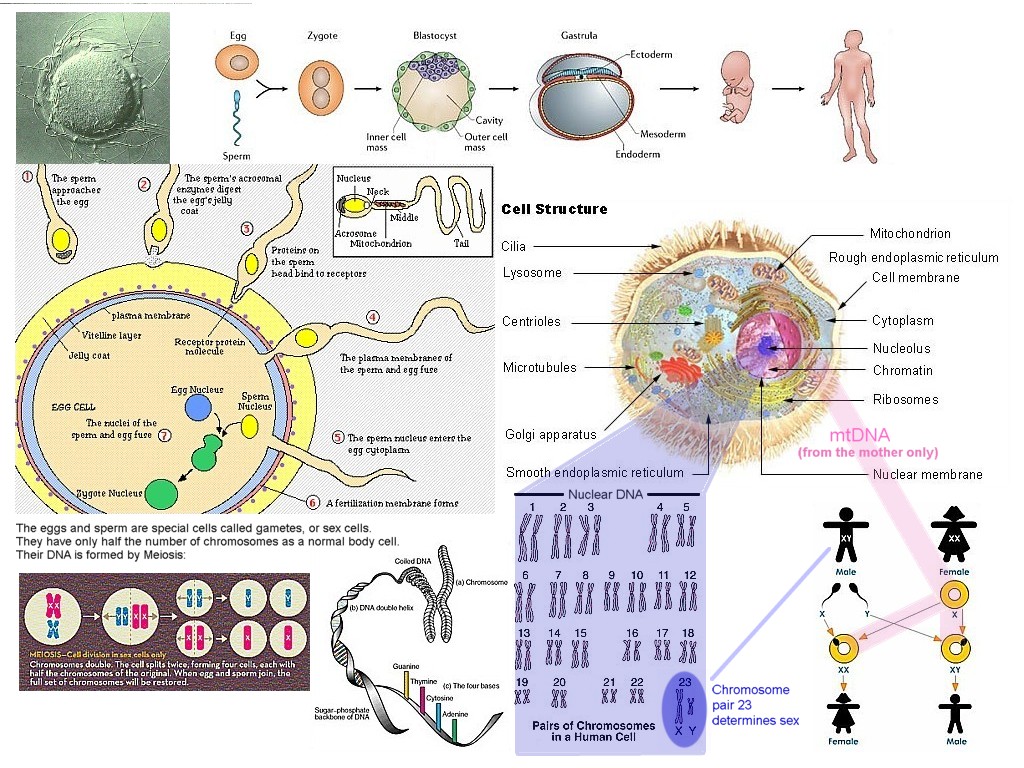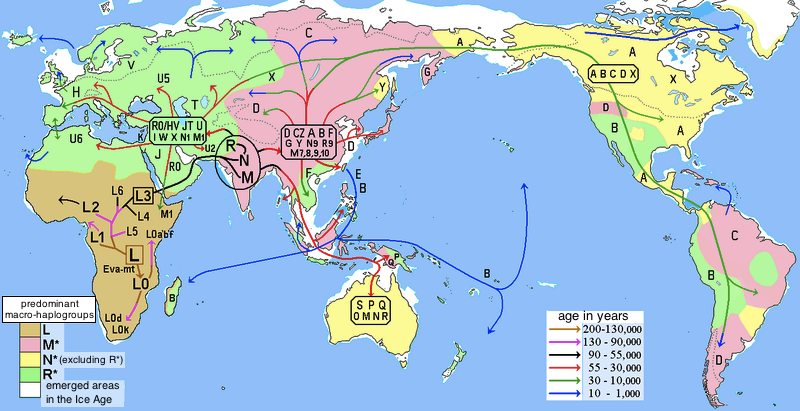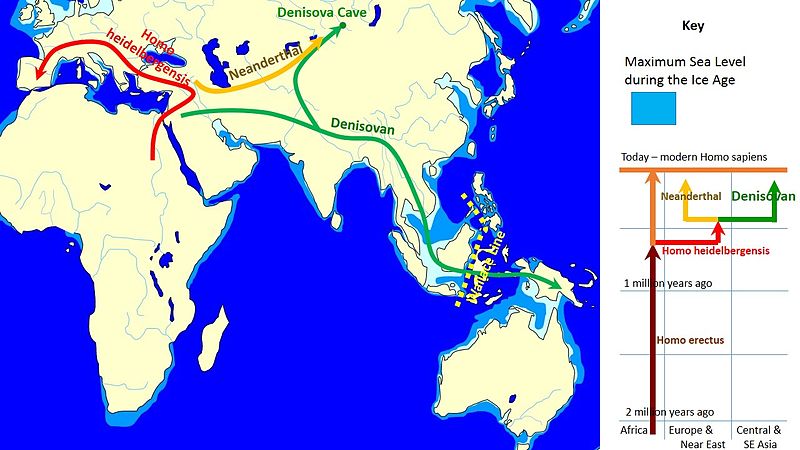DNA evidence
DNA (Deoxyribonucleic acid) is the very long molecule that forms chromosomes and encodes the genes used by all living organisms to reproduce and function. DNA encodes the instructions for creating each cellular colony, defining each species, and each individual within a species. DNA changes over time in such away that each change is a development on previous generations. So it is possible to trace DNA ancestry back through generations of a particular species over time. DNA studies are increasingly shedding light on the questions around human origins.
Most animals, including humans, carry two types of DNA. Our main genome is carried by the chromosomes in the nucleus of each of our cells. This comes from both our parents.
The secondary genome, mtDNA, is carried by bacteria-like organelles within each of our cells, that convert sugars for cell energy, called mitochondria. These are all cloned (reproduced by asexual division) from the mitochondria that were within the original egg cell provided by our mother.
So our mtDNA comes only from our mother; in turn from her mother; and so on and mtDNA allows us to map the female ancestral line.
This original egg cell was fertilised by a sperm from our father (sperm do not contribute their mitochondria). Once fertilised, the egg cell then divided repeatedly, differentiating in accordance with the coding instructions in our DNA, into the many cells that form the cellular colony that became 'us'.
Males are differentiated from females by a Y chromosome in place of one X. So sons can only inherit this from their father (like their family name in our culture) and periodic changes in the DNA of the Y chromosome allow the (actual) male ancestral line to be traced back.
 Human Reproduction - Click here to enlarge
Human Reproduction - Click here to enlarge
Because each cell has numerous mitochondria but only one nucleus, the DNA found in ancient animal remains (for example in teeth) is predominantly mtDNA. If this is confusing, follow this link for a more comprehensive, nontechnical, introduction to genetics.
Many people, like me, have volunteered genetic material to assist in mapping human migration patterns. Others wish to keep this information private and are protected, to a degree, by medical ethics and privacy laws.
An early study produced the following map. It is based on mtDNA and is therefore matrilinear. Later studies including the male line (Y chromosome) and remaining DNA provide a slightly different, but similar, map involving multiple waves of settlement; as discussed later.

Map of human migrations based on mitochondrial DNA haplogroups - scale: thousands of years
Source: Wikimedia Commons
Today there are very few Aboriginal populations that do not also carry European DNA from the early settlers. This can obscure evidence of the original indigenous ancestry and time-line. The few individuals with 'pure Aboriginal' DNA are only found isolated communities in the Northern Territory or in human remains that predate European arrival.
Although there are obviously many sources of aboriginal DNA, ranging from medical and forensic samples to a simple clipping from a hairdresser, DNA studies in Australia have been hampered by "a legacy of distrust of biological research among aboriginal groups means that genetic studies are viewed suspiciously and samples are (ethically) hard to come by". Increased indigenous travel and intermixing within Australia further obscures possible regional genetic differentiation.
In 2011 DNA from a 90 year old hair sample, originally collected by the British ethnologist Alfred Cort Haddon, who was given the hair by a young Aboriginal man in the early 1920s while on a train journey from Sydney to Perth, was sequenced. The research team, led by Eske Willerslev, a palaeogeneticist at the University of Copenhagen, Denmark, obtained approval to sequence his genome from a Danish bioethics review board and also received the approval of a committee that represents Aboriginal people in the region where the man probably lived (Nature 22 September 2011).
Like other populations outside Africa such as Europeans and Asians, this Australian Aboriginal man owed small chunks of his genome to Neanderthals; but his ancestors had also interbred with the Denisovans. Until this sequencing, Papua New Guineans were the only modern human population whose ancestors were known to have interbred with Denisovans. His genome indicates that his ancestors started their journey from the home of the common ancestors, outside Africa, more than 60 thousand years ago.

Spread and evolution of Denisovans (source: Wikipedia)
Using this genome; another Aboriginal from the Northern Territory; and others from the region representing 33 Asian and Oceanian populations; researchers led by Mark Stoneking at the Max Planck Institute for Evolutionary Anthropology in Leipzig, Germany, then calculated the portion of Denisovan ancestry found in the genomes of 243 people (Reported in the American Journal of Human Genetics).
Denisovan ancestry was found in indigenous Australians; together with present-day New Guineans; and an indigenous tribe in the Philippines known as Mamanwa; while the residents of mainland Southeast Asia contained none.
Stoneking says that this pattern hints at at least two waves of human migration into Asia: an early trek that included the ancestors of contemporary Aboriginal Australians, New Guineans and some other Oceanians, followed by a second wave that gave rise to the present residents of mainland Asia. As the ancestors of contemporary Europeans and most other Asians went their separate ways less than 40 thousand years ago, the Denisovans had probably vanished by the time the second wave of Asian migrants arrived.
A more sophisticated Melanesian canoe - made from planks - used for interisland travel
Polynesians and Melanesians were/are able to navigate to islands hundreds of kilometres away
Alan Redd, a biological anthropologist at the University of Kansas in Lawrence, says that the peopling of Australia may have been more complicated than either paper suggests. Dingoes, for instance, were brought to the island continent by humans who arrived in the last 5 thousand years. "It's certainly possible that people were trickling in at different times," he says.
In a more recent study by a team led by Mark Stoneking at the Max Planck Institute for Evolutionary Anthropology the entire genomes of 344 individuals, including aboriginal Australians from the Northern Territory, highlanders from Papua New Guinea, several populations from Southeast Asian and India and a handful of people from the United States and China were compared.
This study revealed that Australians, New Guineans and the Mamanwa diverged around 36 thousand years ago. It suggested that they all descended from an early southward migration out of Africa.
But it also found evidence of more recent genetic mixing, or gene flow, between the Indian and northern Australian populations taking place around 141 generations ago. Thus some aboriginal Australians can trace as much as 11% of their genomes to migrants who reached the Australia around 4 thousand years ago from India.
This gene flow could not have occurred during the initial wave of migration into Australia because it is absent from New Guinean and Mamanwa genomes, and it is too uniformly spread across the northern Aboriginal genomes to have come from European colonists. The study confirms earlier studies of mitochondrial DNA and the Y chromosome that hinted at recent gene flow between India and Australia.
The recent genetic mingling coincided with the arrival in Australia of microliths; small stone tools that formed the tips of weapons; and the first appearance in the fossil record of the dingo, which most closely resembles Indian dogs.
According to the article in Nature: Sheila van Holst Pellekaan, a geneticist at the University of New South Wales, Australia, and a co-author of the earlier genome-wide study, welcomes the latest research, but warns that the finding of Indian genetic material in people from the Northern Territory is “definitely not representative of Australia," because it only looked at people from the Northern Territories. She believes that the Aboriginals' vast genetic diversity suggests that multiple waves of migration could have occurred, but that new genes would not always have dispersed through the pre-existing peoples.
In summary then DNA based evidence suggests that:
- Modern humans arrived in the landmass of Sunda in at least two separate waves.
- The first wave arrived in excess of 50 thousand years ago and interbred with earlier Neanderthal-like hominins known as Denisovans.
- Some then continued south, crossing 30+ km of ocean, to become the first wave of modern humans to populate Australia.
- The second wave were people probably from around Mesopotamia who left there less than 40 thousand years ago; some north to populate Europe; and some south into SE Asia.
- They were technologically more advanced and entirely displaced the earlier group in SE Asia; but not in Australia; the highlands of New Guinea; or part of the Philippines.
- Some people from a later wave, with ancestors in India, migrated to Australia about 4 thousand years ago and interbred with the earlier people; at least in the Northern Territory.
- From about a thousand years ago Melanesians; Polynesians; and then Europeans arrived in Northern Australia and also introduced new genetic diversity and technology.
